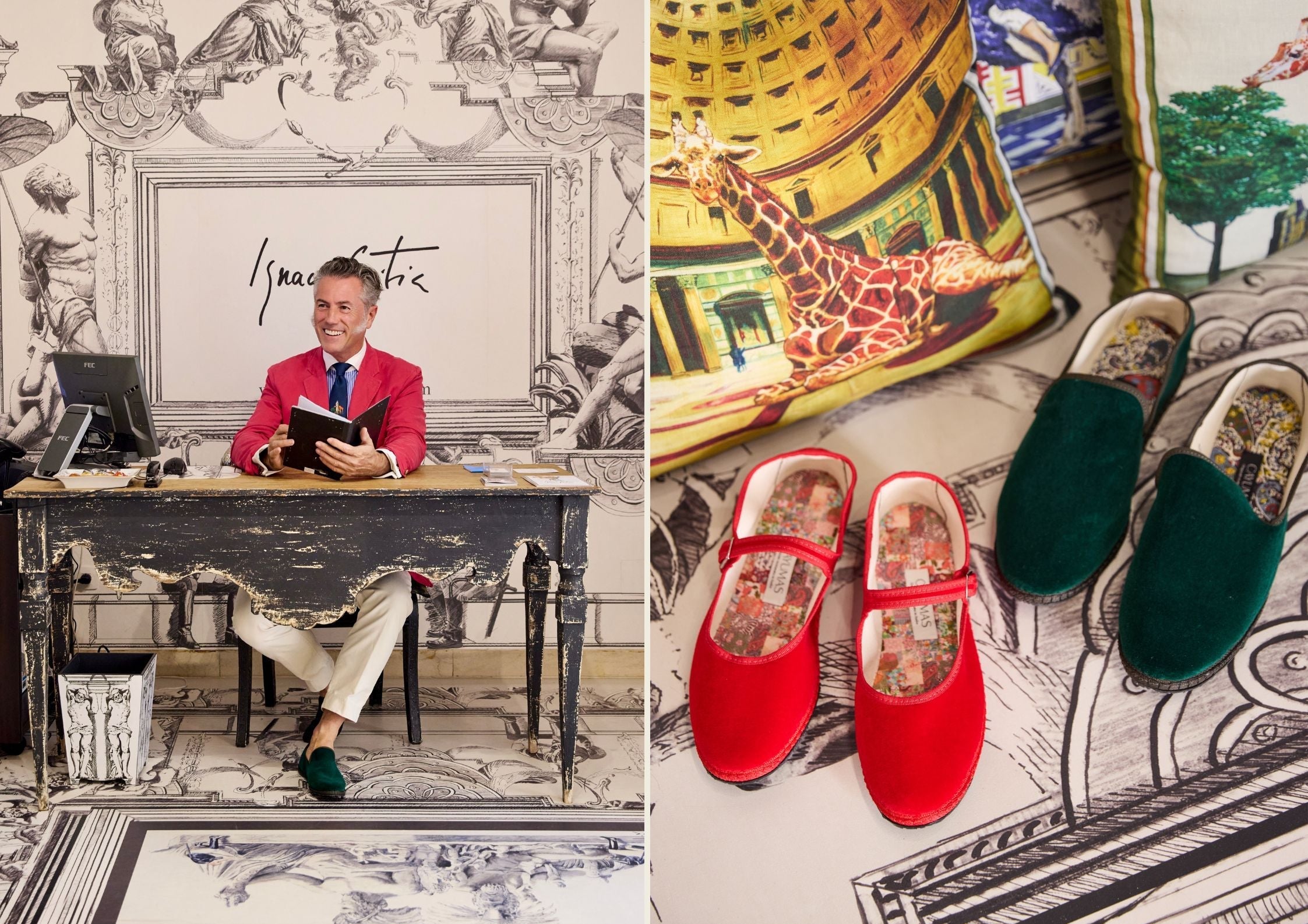Journal 29: Interview with Ignacio Goitia

Ignacio Goitia, a painter born in Bilbao, has turned architecture and nature into the protagonists of a unique artistic universe. With a PhD in Art History, he combines classical monumentality with touches of irony, transferring his works beyond the canvas to scarves, wallpaper, and scenographic projects that invite us to inhabit art.
Your work blends architecture and animals. Could you tell us the thought behind such a powerful combination?
"I have always been fascinated by architecture. In fact, after finishing my degree in Fine Arts and later completing a PhD in Art History, I seriously considered studying Architecture. However, I must admit that mathematics and physics were my weak points. So, instead of building structures, I decided to paint them on canvas.
There are many facets of architecture that captivate me, but one stands out in particular: the semiotics of monumental constructions. How, through scale and form, buildings can convey without words messages about power, authority, and hierarchy. Throughout history, architecture has functioned as a symbolic instrument of power. Grand edifices like palaces, churches, banks, ministries… were designed not only for practical use but also to represent the grandeur of their patrons and legitimize their social or political status.
Into this game of proportions, with a touch of irony, steps one of my favorite animals: the giraffe. Its elongated, elegant figure appears in my works as a visual wink that contrasts with the monumentality of the architecture. It’s as if these spaces were designed not for the might of humans, but for tall, majestic, and somewhat extravagant creatures. After all, even historical figures like Louis XIV who wasn’t very tall resorted to tools like heels to project a more imposing image."
When did you decide to turn a painting into a scarf?
"It happened during my latest exhibition in Miami. I wanted to reach a broader audience beyond galleries and museums, and I thought of trying one of my wallpaper designs used in the installation as a silk scarf. It was a success, and what began as a playful experiment took a turn that changed my life."
Which was the first scarf you designed?
"As I mentioned, the first was inspired by the wallpaper I had begun designing black-and-white boiserie intended to integrate with my paintings. This created a drawn salon where the rest of my work would hang. This vision also transformed how I presented my paintings. During the pandemic, unable to go to the studio, I began coloring them at home, and that’s how my first collection titled Flatiron emerged named after the iconic New York building, featured at its center and surrounded by an extravagant reinterpretation of chinoiserie. These scarves and foulards are now in high demand, and I continue to produce them in different colors. They’ve become one of my classics."
An artistic journey you’ve taken?
"Almost all of them, actually. I’m passionate about travel I’m not one to lie far away on a beach to rest. Every journey is a learning experience and a consistent source of inspiration for my paintings. Many of my art, architecture, urbanism or landscape books at home are filled with sticky notes marking places I’d love to visit in person. Because books are wonderful, but to truly understand and feel them, you have to visit and experience them. Whenever possible, I organize trips around these places. That inspired, for example, a trip to Bavaria where I visited, among others, the Walhalla in Regensburg, the Befreiungshalle in Kelheim, the Glyptothek in Munich and the Propylaea all by architect Leo von Klenze as well as the Würzburg Residence with its grand staircase designed by Balthasar Neumann and crowned with the world’s largest fresco by Tiepolo. A few months later, all these places starred in several of my paintings."
Any projects in progress?
"Yes, many, though I’ll reveal them little by little. One of the many fascinating things about growing older is having the perspective to see how you’ve been steering and building your life—and that if you stay focused and exert effort, you can achieve what you set out to do. It’s curious to see how one project leads to another. After the scenographic exhibition in Miami I mentioned, came even more scenographic ones like my retrospective in Bilbao, which then traveled to Rome and Lisbon. Thanks to them came the success of the museographic installation I created for the exhibition Palabras de viajeros at the National Library, which also broke attendance records.
As I was creating my new stores, I also wanted to bring this into everyday life through the custom wallpaper I make for each client and numerous commissions began to come my way. Unintentionally, I think I’m becoming a bit of a decorator, though with an artistic vision. For example, I’m currently finishing the transformation of a new Basque‑French restaurant at 7 Génova Street for some clients using my wallpapers. I love treating spaces as if they were inhabitable works of art, as if the visitor were inside a drawing or a painting."
What is your favorite hotel?
"The Hôtel du Palais in Biarritz. I love that place. Every time the barrier to the garden gate is lifted for the car to enter, it’s like traveling back in time."
What place in the world would you like to explore wearing your friulane?
"That’s a beautiful question. Well… I’m not sure… I think of the Gipsoteca Canoviana in Possagno a small, fascinating museum, especially if visited by candlelight, as the sculptor Antonio Canova showed it to his clients and friends. It’s near Friuli, the birthplace of the friulane in the 19th century. Who kno perhaps Canova himself wore them in his studio."
How would you design your perfect Cayumas?
"I suppose with one of my paintings printed on fabric, or perhaps with a drawing embroidered on velvet. A few years ago, I collaborated with a well-known slippers brand based in Palm Beach and New York, and I loved the experience."



